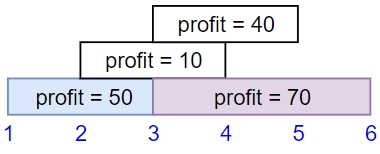1235. Maximum Profit in Job Scheduling
interval,二分
We have n jobs, where every job is scheduled to be done from startTime[i] to endTime[i], obtaining a profit of profit[i].
You're given the startTime, endTime and profit arrays, return the maximum profit you can take such that there are no two jobs in the subset with overlapping time range.
If you choose a job that ends at time X you will be able to start another job that starts at time X.
Example 1:

Input: startTime = [1,2,3,3], endTime = [3,4,5,6], profit = [50,10,40,70]
Output: 120
Explanation: The subset chosen is the first and fourth job.
Time range [1-3]+[3-6] , we get profit of 120 = 50 + 70.Example 2:

Input: startTime = [1,2,3,4,6], endTime = [3,5,10,6,9], profit = [20,20,100,70,60]
Output: 150
Explanation: The subset chosen is the first, fourth and fifth job.
Profit obtained 150 = 20 + 70 + 60.Example 3:

Input: startTime = [1,1,1], endTime = [2,3,4], profit = [5,6,4]
Output: 6
Constraints:
1 <= startTime.length == endTime.length == profit.length <= 5 * 1041 <= startTime[i] < endTime[i] <= 1091 <= profit[i] <= 104
分析:主要是bisect.bisect_right的用法,返回index 需要-1。
Sorting: We first sort all jobs by their end time to enable efficient binary search for compatible jobs.
Dynamic Programming Array:
dp[i]stores the maximum profit achievable with the firstijobsWe initialize
dp[0] = 0(base case: no jobs = no profit)
Processing Each Job:
For each job, we find the last job that doesn't overlap with it using binary search
We then compare:
Taking the current job plus the profit from the last compatible job
Not taking the current job (keeping the previous maximum)
We store the maximum of these two options in
dp[i]
Result: The final answer is in
dp[n], representing the maximum profit from all jobs.
Last updated
Was this helpful?